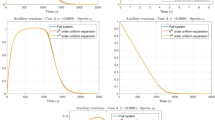Abstract
The Henry–Michaelis–Menten (HMM) mechanism of enzymatic reaction is studied by means of perturbation theory in the reaction rate constant k 2 of product formation. We present analytical solutions that provide the concentrations of the enzyme (E), the substrate (S), as well as those of the enzyme-substrate complex (C), and the product (P) as functions of time. For k 2 small compared to k −1, we properly describe the entire enzymatic activity from the beginning of the reaction up to longer times without imposing extra conditions on the initial concentrations E o and S o , which can be comparable or much different.




Similar content being viewed by others
References
Berberan-Santos, M. N. (2010). A general treatment of Henri–Michaelis–Menten enzyme kinetics: exact series solutions and approximate analytical solutions. MATCH Commun. Math. Comp. Chem., 63, 283.
Borghans, J. A. M., Boer, R. J., & Segel, L. A. (1996). Extending the quasi steady state approximation by changing variables. Bull. Math. Biol., 58, 43–63.
Briggs, G. E., & Haldane, J. B. (1925). A note on the kinetics of enzyme action. Biochem. J., 19, 338–339.
Chen, W. W., Niepel, M., & Sorger, P. K. (2010). Classic and contemporary approaches to modeling biochemical reactions. Genes Dev., 24, 1861–1875.
Dingee, J. W., & Anton, A. B. (2008). A new perturbation solution to the Michaelis–Menten problem. AIChE J., 54, 1344–1357.
Dimicoli, J.-L., Papamichael, E. M., & Sakarellos, C. (1987). Dynamics of elastase peptide complexes a 13C NMR study. Protides Biol. Fluids, 35, 449–452.
Dixon, M., & Webb, E. C. (1964). Enzymes (2nd ed., pp. 63–65, 92–94). London: Longman.
Fersht, A. R. (1999). Structure and mechanism in protein science: a guide to enzyme catalysis and protein folding. New York: Freeman.
Goh, S. M., Noorani, M. S. M., & Hashim, I. (2010). Introducing variational iteration method to a biochemical reaction model. Nonlinear Anal., Real World Appl., 11, 2264–2272.
Hashim, I., Chowdhury, M. S. H., & Mawa, S. (2008). On multistage homotopy-perturbation method applied to nonlinear biochemical reaction model. Chaos Solitons Fractals, 36, 823–827.
He, J. H. (2005). Application of homotopy perturbation method to nonlinear wave equations. Chaos Solitons Fractals, 26, 695–700.
He, J. H. (2007). Variational iteration method—some recent results and new interpretations. J. Comput. Appl. Math., 207, 3–17.
Henri, V. (1902). Theorie generale de l’action de quelques diastases. C. R. Hebd. Séances Acad. Sci., 135, 916–919.
Konermann, L., & Douglas, D. J. (2002). Pre-steady-state kinetics of enzymatic reactions studied by electrospray mass spectroscopy with on-line rapid-mixing techniques. Methods Enzymol., 354, 50–64.
Laidler, K. J. (1955). Theory of the transient phase in kinetics, with special reference to enzyme systems. Can. J. Chem., 33, 1614–1624.
Lewin, L. (1981). Polylogarithms and associated functions. New York: North-Holland.
Lymperopoulos, K., Kosmas, M., & Papamichael, E. M. (1998). A formulation of different equations applied in enzyme kinetics. J. Sci. Ind. Res., 57, 604.
Marangoni, A. G. (2003). Enzyme kinetics: a modern approach. New York: Wiley Interscience.
Michaelis, L., & Menten, M. L. (1913). Die kinetik der invertinwirkung. Biochem. Z., 49, 333–369.
Mendes, P. (1993). GESAPI: a software package for modeling the dynamics, steady states and control of biochemical and other systems. Comput. Appl. Biosci., 9, 563.
Papamichael, E. M., Theodorou, L. G., & Bieth, J. G. (2004). Insight into catalytic mechanism of papain-like cysteine proteinases: the case of D158. Appl. Biochem. Biotechnol., A, 118, 171–175.
Savageau, M. A. (1969). Biochemical systems analysis: I. Some mathematical properties of the rate law for the component enzymatic reactions. J. Theor. Biol., 25, 365–369.
Schnell, S., & Mendoza, C. (1997). Closed form solution for time dependent enzyme kinetics. J. Theor. Biol., 187, 207–212.
Schnell, S., & Maini, P. K. (2000). Enzyme kinetics at high enzyme concentrations. Bull. Math. Biol., 62, 483–499.
Segel, I. (1975). Enzyme kinetics: behavior and analysis of rapid equilibrium and steady-state kinetic enzyme systems (pp. 18–29). New York: Wiley, and the relative cited literature of chapter two.
Segel, L. A. (1988). On the validity of the steady-state assumption of enzyme kinetics. Bull. Math. Biol., 50, 579–593.
Segel, L. A., & Slemrod, M. (1989). The quasi-steady-state assumption: a case in perturbation. SIAM Rev., 31, 446–477.
Senior, S. Z., Mans, L. L., vanGuilder, H. D., Kelly, K. A., Hendrich, M. P., & Elgren, T. E. (2003). Catecholase activity associated with copper-S100B. Biochemistry, 42, 4392–4397.
Swoboda, P. A. T. (1957). The kinetics of enzyme action. Biochim. Biophys. Acta, 23, 70–80.
Theodorou, L. G., Bieth, J. G., & Papamichael, E. M. (2007). The catalytic mode of cysteine proteinases of papain (C1) family. Bioresour. Technol., 98, 1931–1939.
Tzafriri, A. R. (2003). Michaelis–Menten kinetics at high enzyme concentrations. Bull. Math. Biol., 65, 1111–1129.
Tzafriri, A. R., & Edelman, E. R. (2007). Quasi-steady-state kinetics at enzyme and substrate concentrations in excess of the Michaelis–Menten constant. J. Theor. Biol., 245, 737–748.
Van Slyke, D. D., & Cullen, G. E. (1914). The mode of action of urease and of enzymes in general. J. Biol. Chem., 19, 141–180.
Voet, D., Voet, J. G., & Pratt, C. W. (1999). Fundamentals of biochemistry. New York: Wiley
Wong, J. T.-F. (1965). On the steady-state method of enzyme kinetics. J. Am. Chem. Soc., 87, 1788–1793.
Zechel, D. L., Konermann, L., Withers, S. G., & Douglas, D. J. (1998). Pre-steady state kinetic analysis of an enzymatic reaction monitored by time-resolved electrospray ionization mass spectrometry. Biochemistry, 37, 7664–7669.
Acknowledgements
We thank the unknown referees for their useful and constructive criticism.
Author information
Authors and Affiliations
Corresponding author
Rights and permissions
About this article
Cite this article
Bakalis, E., Kosmas, M. & Papamichael, E.M. Perturbation Theory in the Catalytic Rate Constant of the Henri–Michaelis–Menten Enzymatic Reaction. Bull Math Biol 74, 2535–2546 (2012). https://doi.org/10.1007/s11538-012-9761-x
Received:
Accepted:
Published:
Issue Date:
DOI: https://doi.org/10.1007/s11538-012-9761-x




